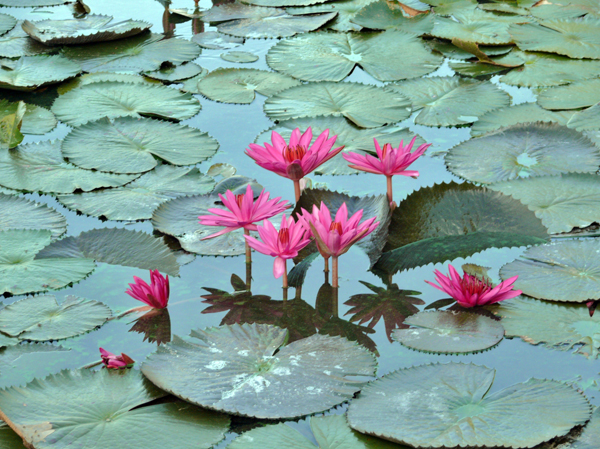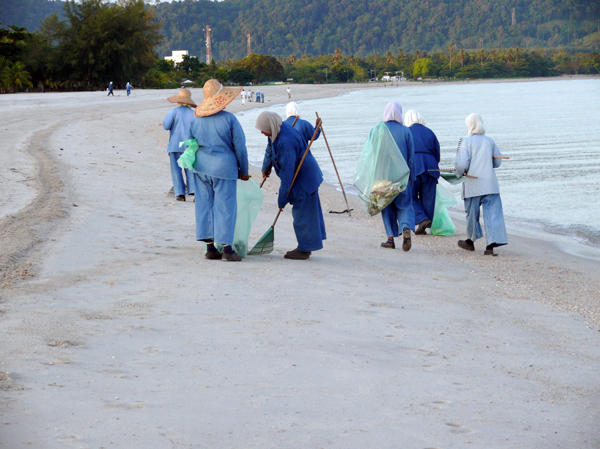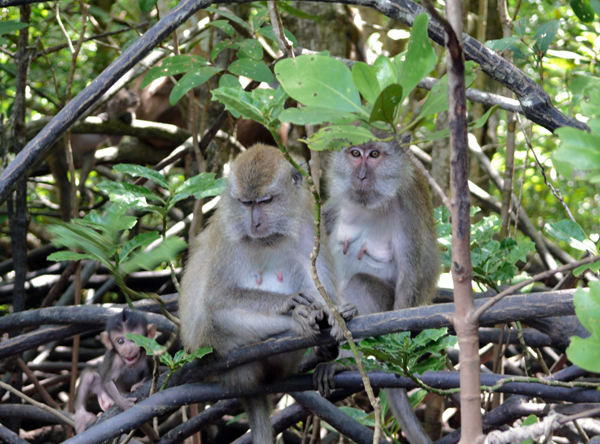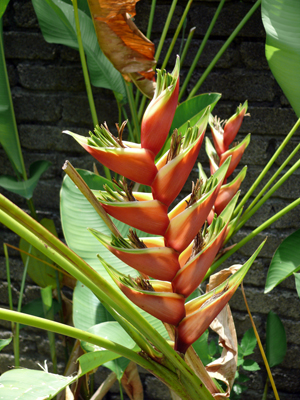LANGKAWI, MALAYSIA - The sun slowly rises over the tallest peak on Friday Mountain, signaling another glorious day is about to begin on this tropical island outpost. Despite the early hour, the Andaman Sea beach outside the Four Seasons Langkawi Resort is hot to the touch. Debris, washed ashore overnight, is being swept up and bagged by an army of local women dressed in denim overalls. Their heads are covered with straw hats and scarves, as Muslim dress code demands. The pampered guests staying at Langkawi’s most luxurious resort will never see the old car seats, driftwood or plastic bottles the sea spit out while they slept.
Each of the round faced women with the olive oil skin and lovely features bids the stranger walking the beach a hearty “good morning sir.”
Down the shoreline, I see a man wearing a floppy hat in khaki shirt and shorts walking toward me. As the distance between us closes, the man calls out my name.
When Aidi Abdullah and I come face-to-face, he sticks out his hand and offers me a hearty shake.
“I hope you approve of the morning we have ordered for you sir,” says the Four Seasons Resort’s resident naturalist.


Left: Mangroves are filled with beautiful vegetation. Right: Women sweeps island's beaches every day.
The charming Aidi, who leads guests on excursions through the island’s treasured mangrove – the entrance is just down the beach from the hotel - talks in eloquent tones; almost professor like. But he’s quick with the quips and his sly smile suggests he’s a bit of a prankster.
We’re going to get along just fine.
“I know Canada well,” says Aidi. “Spent some time in Edmonton and I truly love your country. Sometimes I think I should have stayed there.
“Hop aboard the boat (a small canopied skiff) and we’ll get started,” says Aidi, who introduces me to the man piloting the small craft.
“Ismaeil (the captain) has the eyes of an eagle – he spots things even I can’t see,” says Aidi.
Soon we are under way and Aidi is filling my head with all sorts of facts about the precious mangrove, which he calls the “lungs” of this archipelago made up of 99 islands located in northern Malaysia – in sight of Thailand’s rugged mountainous coast.
The mangrove tour lasts about four hours and introduces visitors to rare creatures like walking fish, playful monkeys, five-million-year-old limestone rock formations and giant eagles.
As we move closer to the entrance of the delicate 14 square kilometer mangrove, Aidi points to a creature breaking the surface of the water and identifies it as a water monitor – a lizard-like creature that survives very well in these parts.
“The water monitor can swim up to 15 kilometres without taking a break,” Aidi informs me as some faster boats whiz past full of tourists – Langkawi’s mangroves attract over 290,000 visitors a year.
Ismaeil doesn’t follow the other boats but instead turns our small craft towards the shoreline where I see some strange-looking trees whose tangled roots sit exposed atop the muddy landscape.
“Sea water is toxic to plants so the roots of these trees have adapted by coming to the surface where they are able to soak in rain water,” says Aidi, a self-taught biologist who has been guiding mangrove tours for about 10 years now.
“There are 79 varieties of plant life in our mangrove and 63 per cent of sea life depends on the mangrove to survive,” says Aidi about an area which achieved World Geopark status from UNESCO in 2007.
Giant limestone outcroppings mark the entrance to the mangrove and Geopark and once inside, our captain again heads for shore.
“Look, do you see that walking fish?” asks Aidi as we scan the shallow water for the mudskippers our guide tells us may be the “missing link.” The mudskipper looks like a fish, swims like a fish, but walks on land.
“The mudskipper stores air in his bulging cheeks and is the only fish that can live both on land and water,” says the guide.
Further along the muddy shoreline, Aidi points to some colourful fiddler crabs and tells me these are his favourite residents of the mangrove.
“They are simply incredible – the way they survive and prosper here comes down to how they are able to shelter themselves from the sea,” says Aidi, as we watch in amazement as one bright orange and blue crab cuts a perfectly-rounded “door” out of the mud and then drags it to a hole where he crawls inside and places the “door” on top. Within seconds, we can’t even see where the hole once was.
“They come out of their holes when the tide is out to feed and then return when the tide returns – the door protects them from the sea,” says Aidi.
Suddenly, we come upon the fleet of tourist boats that sped past us earlier. They are all gathered at one point in the river.
“Oh,” says Aidi, “there must be a monkey show going on.”
Sure enough, dozens of Macques monkeys are swinging from tree-to-tree keeping the tourists amused. Several have jumped onto the boats and are being fed. The youngest tourists are wide-eyed with amazement.
Aidi just shakes his head as one of the monkeys gets a potato chip bag stuck on its head.
“Things like potato chips, bread and cookies are very dangerous for these monkeys – food like that will kill them,” says Aidi, who scolds one of the captains for allowing his passengers to give the fun-loving creature the bag of chips.
However, the guide tells me food like fruit that tourists give the monkeys is good because “otherwise the monkeys will turn to cannibalism to stay alive.”
Suddenly, a alpha male arrives on the scene and the rest of the monkeys scurry into the bushes. The alpha male rules and gathers up all the food for himself – even the now empty bag of chips.


Left: Some residents of the mangrove are very unique. Right: The mangrove is a Garden of Eden.
As we float gently through the narrow channels well inside the mangrove, Ismaeil cuts the engine. “He’s seen something,” whispers Aidi, who stops his commentary.
The captain then points to the thick branches hanging over the river like a canopy and Aidi says: “Oh my god, look deep inside – do you see it – the viper?”
At the mere mention of the word “viper” I recoil but as I make out the snake’s sleek body wrapped around the tree limbs I crane my neck to get a better view.”
“I told you Ismaeil has the eyes of an eagle. He can spot well camouflaged snakes from the river and the other day he spotted a cobra.”
As we continue to float gently past giant sonneratia trees that line the narrow channels where the air is dewy sweet, Aidi tells me that 20 per cent of the Four Seasons’ guests take the mangrove tour – the other 80 per cent don’t know that they are missing.
The greatest thrill for the entertaining guide is when young guests email him to tell him that they’ve shared their mangrove experience with fellow students when they got back home.
It’s one breathtaking National Geographic moment after another in this area of Malaysia which Aidi calls “Borneo light.”
Soon, we leave the narrow channels and float into a bay where the sky is filled with giant eagles that are dive bombing for their fish dinner. Cameras whirl as the tourists try to capture the majestic birds with the wingspan of a 747 as they skim the surface and pluck massive fish out of the water.
Near the spot where we exit the mangrove, we come upon a fleet of giant sailing boats which Aidi tells me came from as far away as New Zealand, Europe and California.
“The sailors sailed into Langkawi and decided to leave their boats here,” Aidi tells me. “They return each year and sail around the Andaman Sea for a few weeks before going back home again.”
We exit the mangrove and thinking the thrill ride is over, I thank Aidi and Ismaeil for one of the most exciting experiences of my life. “Oh, it’s not over yet,” says Aidi, who points out to sea where a large school of dolphins are jumping out of the water.
The captain guns the small boat’s engines and soon we are floating alongside the majestic dolphins, following them back to the Four Seasons dock.
Beautiful Langkawi is known as an island of mountains and myths but it’s its mangrove that makes a visit here very special.
The mangrove tour offered by Four Seasons costs about $70 per person. There are cheaper tours but the Four Seasons is a private adventure which Aidi makes very special. For information on the Four Seasons Langkawi property, go to fourseasons.com/langkawi
The best way to get to Langkawi from Canada is via Singapore with Singapore Airlines. Singapore Airlines offers direct daily flights to Singapore from Newark, N.J. Air Canada and Porter Airlines offer flights to Newark from Toronto.
Facts About Langkawi
- Langkawi boasts a population of about 65,000
- Langkawi’s climate is tropical – sunny, hot and humid – but the island’s short rainy season runs between August and September. Average temperature is 32C.
- The island’s oldest geological formation is Gunung Matchincang, which was the first part of Southeast Asia to rise from the seabed in the Cambrian period – about a half billion years ago.
- Only a few of the 99 island that make up Langkawi are inhabited.
- Malay make up the majority of Langkawi, followed by Chinese, Indians and Thai. Islam is the main religion practiced on Langkawi.
- One of the main tourist attractions on Langkawi is Pregnant Maiden Lake, where, legend has it, one sip of the water is said to help a woman get pregnant.
- The sunsets on Langkawi are among the most beautiful in the world.
- Over 200 species of birds make Langkawi their home.
- Alcohol prices on tax-free Langkawi are some of the cheapest in the world.
- There are many myths and legends about Langkawi and a curse was placed on the island by a princess – she no doubt wanted to keep its beauty all to herself.
- Rental cars and motorbikes are relatively inexpensive on Langkawi and full-day taxi tours of the main island cost less than $60 U.S.
About the Author
Marc Atchison is a veteran journalist and a seasoned traveller with more than 20 years of travel writing experience. As the former Travel Editor of the Toronto Star, Canada's largest newspaper, and now Editor-in-Chief and Senior Writer for TraveLife magazine (Canada) and travelife.ca, Marc has been to over 100 countries in the world. Japan is one of his favorite destinations and he's been there on numerous occasions.